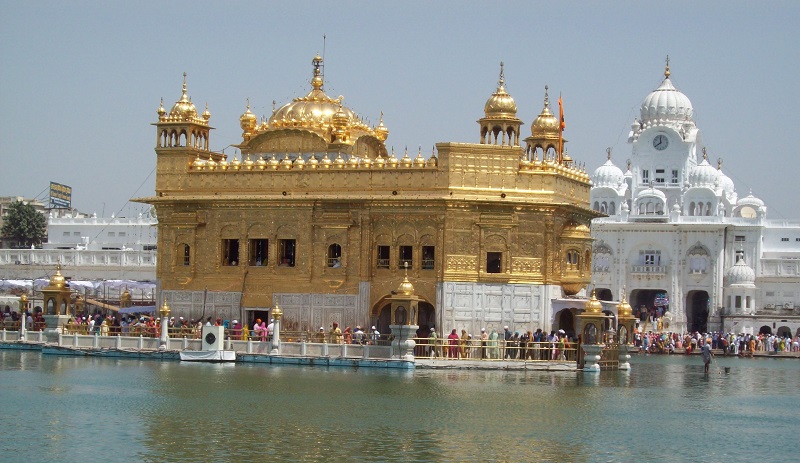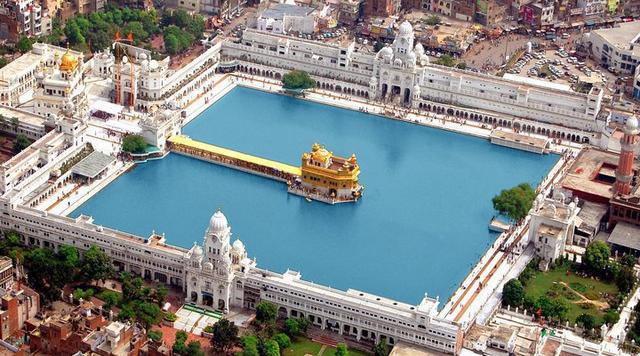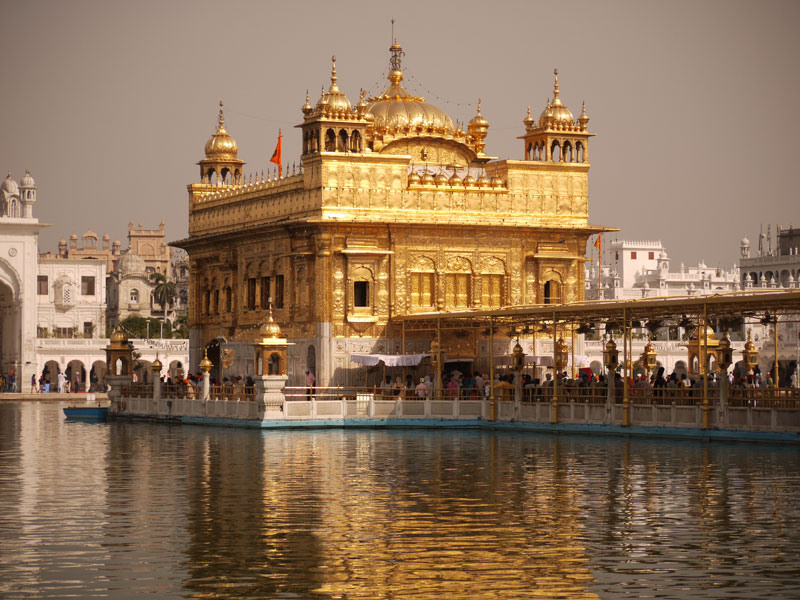Golden Temple, Amritsar
The Golden Temple, formally known as Sri Harmandir Sahib, is a Sikh Gurdwara in the city of Amritsar, Punjab, India.
It was built as a place of worship for all religions, and is considered the holiest Gurdwara of Sikhism. The symbolic openness of the Sikhs is represented by the four entrances used to enter the Gurdwara. It also includes the world’s largest free kitchen, capable of serving food to 300,000 people a day.
The structure dates back to the 16th century, when the site was acquired from the landlords of local villages, with the intention of establishing a new town settlement. Excavation of the 22,943.25 sq.m lake known as a Sarovar (the tank) but actually called Amritsar (Pool of the Nectar of Immortality) began in 1570, and gave the name to the city that developed around it. The tank was intended to be God’s home and whoever bathed in it would obtain spiritual and temporal advantages. It is fed by the Ravi River.
The normal custom had been for a Gurdwara to be built on high land; however, it was decided to build at a lower level so that worshippers would have to descend steps to enter it.
Construction was completed in 1604.
The temple is built on a 4177 sq. ft platform and is approached by a causeway of roughly 60 m in length. The Darshani Deorhi Arch stands at the beginning of the causeway, measuring 6.2 m (20.3 ft) high and 6 m (20 ft) wide.
The main structure is three storeys high. The bridge-facing front is decorated with repeated cusped arches. At the top of the first floor, 4 ft-high parapets rise on all sides. Balconied windows project on carved brackets or bay windows with shallow elliptical cornices.
A low-fluted golden dome sits at the top, with a lotus petal motif in relief at the base. There are also several miniature fluted domes covered with gilded copper.
Inside the Gurdwara memorial plaques commemorate past Sikh historical events, martyrs and saints.
The temple had to undergo substantial rebuilding in the 1760s, after it was attacked by the Afghan army. In the early-19th century, Maharaja Ranjit Singh secured the Punjab region from further attack and set about covering the Gurdwara’s upper floors with 750 kg of gold gilding and marblework, providing the temple with its distinctive appearance. The gold plating was completed in 1830.
[edit] Related articles on Designing Buildings Wiki
- Angkor Wat.
- Building of the week series.
- Dome of the Rock.
- El Castillo.
- Forbidden City.
- Great Mosque of Djenne.
- India looks at using plastic instead of sand.
- India needs to build more infrastructure fast. Here's how.
- Indian construction industry.
- Indian infrastructure.
- Hagia Sophia.
- Mahabat Maqbara, India.
- Shah Cheragh, Iran.
- Taj Mahal.
- Vastu Shastra.
- Vrindavan Chandrodaya Mandir.
Featured articles and news
Professional practical experience for Architects in training
The long process to transform the nature of education and professional practical experience in the Architecture profession following recent reports.
A people-first approach to retrofit
Moving away from the destructive paradigm of fabric-first.
International Electrician Day, 10 June 2025
Celebrating the role of electrical engineers from André-Marie Amperè, today and for the future.
New guide for clients launched at Houses of Parliament
'There has never been a more important time for clients to step up and ...ask the right questions'
The impact of recycled slate tiles
Innovation across the decades.
EPC changes for existing buildings
Changes and their context as the new RdSAP methodology comes into use from 15 June.
Skills England publishes Sector skills needs assessments
Priority areas relating to the built environment highlighted and described in brief.
BSRIA HVAC Market Watch - May 2025 Edition
Heat Pump Market Outlook: Policy, Performance & Refrigerant Trends for 2025–2028.
Committing to EDI in construction with CIOB
Built Environment professional bodies deepen commitment to EDI with two new signatories: CIAT and CICES.
Government Grenfell progress report at a glance
Line by line recomendation overview, with links to more details.
An engaging and lively review of his professional life.
Sustainable heating for listed buildings
A problem that needs to be approached intelligently.
50th Golden anniversary ECA Edmundson apprentice award
Deadline for entries has been extended to Friday 27 June, so don't miss out!
CIAT at the London Festival of Architecture
Designing for Everyone: Breaking Barriers in Inclusive Architecture.
Mixed reactions to apprenticeship and skills reform 2025
A 'welcome shift' for some and a 'backwards step' for others.

























Comments
You written that temple is built on 67 square feet platform does not seem right. Also the size of Sarovar is 22,943.25 square m. Not 150 square m.
67ft x 67ft and 150m x 150m